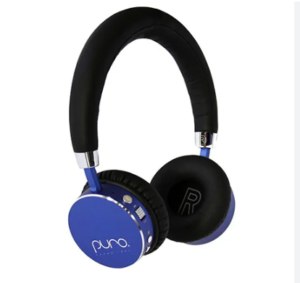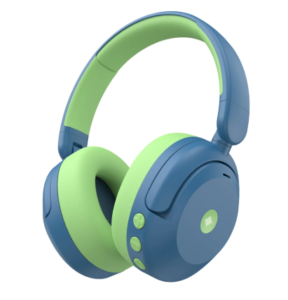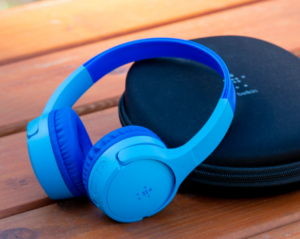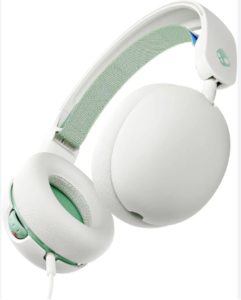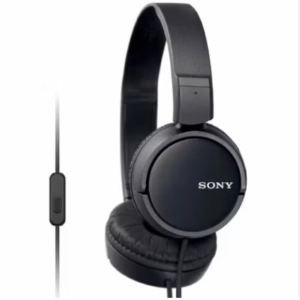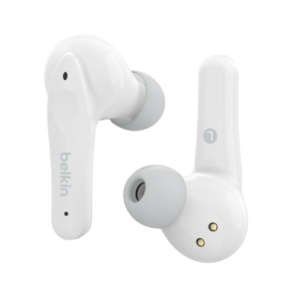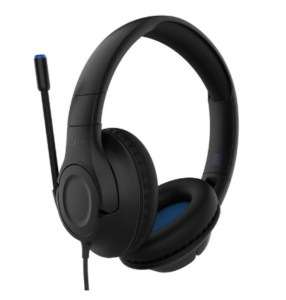Parents should look for headphones designed for children. Headphones designed for children are lighter and easier to use than adult headphones.
Not all children’s headphones have noise-canceling features, but they are more likely to have them than adult headphones.
If the volume control is easy to use, children are more likely to use it to turn down the volume on their device. We purchased and tested 10 leading competitors to find the best children’s headphones.
Top 10 Best Kids Headphones in 2025
1. Puro Sound Labs
From clear, balanced sound to a Bluetooth range of up to 30 feet (9 meters), the Puro Sound Labs headphones were a big hit with our testers.
Parents loved the volume limiter, which allows adults to adjust it themselves.
Even at max volume, our testers said there was little to no distortion. The headphones boast a “noise-isolating” feature that blocks 83% of ambient noise.
They can be worn on or over the ear for a better seal and comfort, and the premium vegan leather ear cushions and headband impressed our testers during long sessions.
The control buttons, conveniently located on the back of the left headphone earcup, are responsive and easy for kids to use.
The headphones are a bit small, and our testers wish they were a little bigger for older kids. Even at full extension, they don’t fit adult heads, so we wouldn’t recommend using them with kids.
2. Happy Plugs Play
The Happy Plugs Play offers two main advantages: a sleek Swedish design and a loudness of over 85dB.
That means your kids won’t suddenly find the design awkward or be drawn to louder modes. It also offers a balanced sound with a focus on mids and highs.
If your child prefers a minimalist design, the Happy Plugs are a great choice. They support the AptX codec, making them particularly suitable for use with Android devices.
Keep in mind, though, that you’ll have to pay a premium price for all these features.
3. Puro Sound Labs
The Puro Sound Labs headphones are a pretty high-end design for kid’s headphones, and they are much more premium than their price suggests.
They are Bluetooth-enabled, easy to pair, and come with a charging and listening cord.
The headphones are easy to adjust, provide just the right amount of tension for a comfortable fit without moving around, and won’t cause headaches or discomfort.
The earcups are well cushioned and infinitely rotatable to provide a custom fit. Our kid testers said, “They are the most comfortable and sound the best.”
Even for swaying children, they held up better than other competing products, and there was no wire to keep the headphones from getting tangled or falling out while playing or walking.
These kids’ headphones also block out most of the surrounding noise, allowing children to hear better at lower volumes and protecting their hearing.
These kids’ headphones are among the most expensive we’ve tested, so they’re not the best choice if you’re on a budget or if your kids aren’t mature enough to handle expensive electronics (we’ve been there).
As such, the Puro isn’t the best choice for younger children or kids who haven’t yet learned to be careful with their belongings.
A broken pair of expensive kids’ headphones is much more painful than a broken pair of cheap ones. Our tester broke a pair of Puro headphones after just one year by stepping on them.
“I fell out of bed at night and didn’t realize it until I stepped on it,” he said. If you want a good pair of headphones but aren’t ready to spend that much money, the Sony ZX series is a great choice that offers better sound quality than most of the competition.
Overall, we think the Puro is the best in this group. We’d recommend them to a friend who doesn’t care about budget and who values quality, usability, and comfort above all else.
4. iClever BTH20
You probably already know how useful it is to have a pair of Bose over-ear headphones or Sony headphones.
The best noise-canceling headphones are great for airplanes and other noisy environments, allowing you to listen to music without having to turn up the volume.
Kids can experience the same effect with the iClever BTH20, a pair of comfortable active noise-canceling (ANC) headphones.
These headphones offer two levels of noise-canceling, low and high, and automatically set a volume limit of 85 decibels. You can also turn the noise-canceling off completely.
The soft, cushioned ear pads make them easy to use and comfortable to wear, and I also like that they fold up for travel. However, it only comes with a soft travel pouch, not a dedicated case.
Easy controls for playback, volume, and noise control, and easy charging via USB-C port.
Battery life is 35 hours with ANC on and up to 60 hours with it off. Overall, it’s a good buy, and if you need headphones for your kids when traveling, it’s a good value option.
5. Belkin SoundForm Mini
These popular wireless kids’ headphones come from premium accessory maker Belkin and come in pink, blue, white, and black.
In terms of sound quality, they’re just as good as the iClever BTH22 reviewed above.
While they’re a bit smaller and don’t have the flashy RGB lighting effects of the iClever BTH12 reviewed below, the design is very smart.
Since they are not foldable, they are a bit more fragile to store than other headphones.
The SoundForm Mini headphones feature large, simple, and easy-to-use control buttons. There are buttons for volume, play/pause, next/previous track, answer/end calls, and reject calls.
The maximum volume is limited to 85dB. I wish there was a lower volume option like 74dB like some of the iClever kids’ headphones, but this volume can be easily reduced with a few presses of the button.
85dB is not too loud, and as long as your child does not wear them for long periods of time, they should be fine for long-term use.
The headphones are comfortable, and the design is not overly childish, but they do include stickers for fun customization.
The battery life is claimed to be 30 hours. An audio cable is included in case the battery dies. Fortunately, some headphones charge via the USB-C port instead of MicroUSB.
There is a built-in microphone, so you can talk to friends or teachers in remote learning situations.
6. Creative Sound Blaster Jam V2
I loved Creative’s original Sound Blaster Jam headphones back in 2015. They had a retro look and feel and great sound for the price.
Now, they’re available in a 2.0 version with a few major upgrades, including Bluetooth 5.0, USB-C charging, improved call quality, and multipoint Bluetooth pairing for pairing two devices at the same time. Battery life is up to 22 hours.
I was able to switch audio after pairing this wireless headphone set to my Mac Mini and iPhone 12 Pro.
While Bluetooth headphones often have issues pairing to both Mac and Windows PCs, I found them to be a great choice for working from home.
They’re also a great value for parents looking for a pair of headphones for their kids that are great for distance learning and everyday life.
Comfortable on-ear headphones, the Jam V2 are lightweight, have a balanced sound with rich, detailed bass, and plenty of bass.
In my tests, call quality was good, and callers on the other end of the line were able to hear me well, even on the noisy streets of New York.
The carrying pouch is not included, but extra foam ear pads are included, which you may want to keep in mind as they may wear out over time.
The headphones have physical buttons to control volume and playback and support the aptX codec for devices that support wireless streaming codecs.
7. Skullcandy Grom Wireless
The Skullcandy Grom Wireless headphones are a lot more stylish than most kids’ headphones we’ve tested, and they feature an adjustable inner canvas headband strap that can fit a variety of head sizes and shapes.
The on-ear controls work well, and we like the convenient audio sharing feature that works via the 3.5mm input on the right earcup.
They also offer a balanced audio response overall, with surprisingly deep bass and refined highs.
If your child is sensitive to headphone fit or design, these Skullcandy headphones will solve both problems. They boast a stylish design, high-quality audio, and up to 45 hours of battery life.
8. Sony Wired On-Ear Headphones
Since they’re wired, no manual or pairing is required. Kids can just plug them in and enjoy. To maintain a safe volume level, lower the volume on your device instead of your headphones.
Whether you’re listening to music, watching a movie, or playing a game, you can enjoy great sound without having to turn the volume up too high.
According to our testers, the biggest selling point of this set was the sound quality. The crisp, clear, and balanced sound paired well with a variety of audio devices.
The swivel, foldable earcup design provides excellent sound isolation while also making it easy to store when not in use. The durable, tangle-free cable keeps you tangled up in the cord, allowing you to fully focus on your music.
Our testers said that these headphones felt cheap and flimsy, but they worked without any damage during our testing. There is no volume control on the headphones, so be mindful of the volume level of your connected device.
9. Belkin SoundForm Nano True
If you’re buying headphones for your older kids, you might want to consider an AirPods alternative.
In our testing, the kid-friendly Belkin Nano earbuds were a great choice. Belkin states that they’re only suitable for kids 7 and up, so we’d like to emphasize that we only recommend this for older kids.
The parts on this device are too small for younger kids, making them easy to lose or swallow.
However, if you’re considering the right age range, this could be perfect. The sound is solid, the wireless connection is easy, and the freedom of being completely wireless is topped off with a generous battery life.
Of course, like the others on this list, they have a volume limit of up to 85 dB.
10. Belkin SoundForm Inspire
Belkin is a trusted name in the audio industry, and their SoundForm headphones and earbuds lineup is now available in a kids’ set.
Connected via Bluetooth 5.2, the SoundForm Inspire is the perfect pair of headphones for older kids.
Affordable, stylish, and comfortable to wear, the SoundForm Inspire headphones deliver great sound quality.
They also feature a non-removable, foldable boom mic that’s great for online classes or chatting with friends.
If you’re looking for a microphone for video calls or online learning, you’ll want to consider using the boom mic.
The volume is capped at 85dB. If you’re looking for a similar product with a lower volume limit, check out the BuddyPhones Cosmos+ in our review below, which boasts premium audio quality.
With up to 35 hours of playback time, the fast USB-C charging means you’ll have plenty of time to charge your phone before it’s fully charged.
If your battery runs out, you can connect directly to your audio source using the included 3.5mm audio cable. You can also share your audio with other SoundForm users via “RockStar Mode.”
I am very pleased that it is made of recycled plastic materials and has 100% plastic-free packaging.
It may look a bit tacky without the cute stickers like some kids’ headphones, but it may appeal to older kids who don’t want fancy headphones with princess or animal themes.
FAQs
Should I buy children’s headphones with a volume limiter?
A volume limiter on headphones sets a maximum volume within a safe hearing range to protect your child’s ears.
Many smartphones and tablets, including iPhones and iPads, also have volume limits, so it’s not essential to have a volume limiter on the headphones themselves.
However, some parents prefer to go through the hassle of digging through the device’s settings menu to set a volume limiter and prefer a volume limiter built into the headphones.
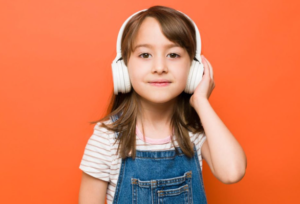
Are noise-cancelling headphones safe for kids?
While I have not tested the noise-cancelling headphones included in this list, I would say that these models are safe for kids and have the advantage of reducing outside noise, making it less likely for kids to turn up the volume to mask the surrounding noise.
One of the downsides of the models I tested and included here is that they lack passive isolation, which means that kids will hear a lot of ambient noise from trains or other noisy vehicles.
For the same reason, most models may not be suitable for use on airplanes.
If you have an iPhone or iPad, it’s a good idea to know that you can limit the volume in your system settings (and protect your hearing!).
Noise-cancelling headphones also help keep the volume low by blocking out surrounding noise.
Are wireless headphones dangerous for children?
Wireless headphones themselves are not dangerous for children. Rather, they are somewhat safer because there is no risk of the long cord getting caught around the neck and causing strangulation.
Children, especially young children, are more likely to chew on the cord of wired headphones because they like to use their mouths and new teeth.
The biggest risk with wireless headphones is that, unlike wired headphones, they need to be charged, meaning that the battery can run out, and you can’t use the headphones until you recharge them.
Can my child use earbuds?
In-ear headphones can be more harmful to your child’s ears than on-ear or over-ear headphones (when played at high volume).
While children may use AirPods or other in-ear earphones, on-ear or over-ear headphones are safer for their hearing health.
However, it’s important to keep the volume of any headphones you use at a safe level for your child’s hearing.
Also read: Where Does AKG Headphone Manufacture?

